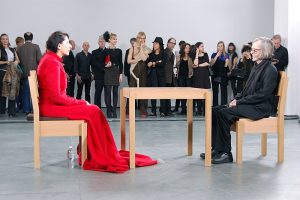9.3 Performance Art
Performance and Body Art
Performance emerged alongside conceptual art to challenge notions of institutional visual art.
Key Points
- Conceptual art emerged as a movement during the 1960s. In part, it was a reaction against formalism as articulated by the influential New York art critic Clement Greenberg.
- Some have argued that conceptual art continued this dematerialization of art by removing the need for objects altogether, while others, including many of the artists themselves, saw conceptual art as a radical break with Greenberg’s kind of formalist Modernism.
- Performance art is traditionally an interdisciplinary performance presented to an audience. It may be scripted or unscripted, random or carefully orchestrated, spontaneous or planned, and occur with or without audience participation. It generally involves the body of the artist herself.
Background
Performance art is a traditionally interdisciplinary performance presented to an audience. It may be scripted or unscripted, random or carefully orchestrated, spontaneous or otherwise planned, and occur with or without audience participation. The performance can be live or distributed via media; the performer can be present or absent. Any situation that involves the four basic elements of time, space, the performer’s body or presence in a medium, and a relationship between the performer and the audience can be considered performance art. It can happen anywhere, in any venue or setting, and for any length of time.

Contemporary Influence In Conceptual and Performance Art
The first wave of the conceptual art movement extended from approximately 1967 to 1978, influenced by early concept artists like Henry Flynt, Robert Morris, and Ray Johnson. Conceptual artists like Dan Graham, Hans Haacke, and Lawrence Weiner have proven very influential on subsequent artists, and well-known contemporary artists such as Mike Kelley or Tracey Emin are sometimes labeled “second- or third-generation” conceptualists, or post-conceptual artists.
Contemporary artists have adopted many of the concerns of the conceptual art movement. While these artists may or may not identify themselves as conceptual artists, ideas such as anti- commodification, social and political critique, and ideas/information as medium continue to have a place in contemporary art, especially among artists working with installation art, performance art, net art, and digital art.
Visual Arts, Performing Arts, and Art Performance
Performance art is an essentially contested concept: any single definition implies the recognition of rival uses. Like concepts such as ”democracy” or “art,” it implies productive disagreement with itself.
The narrower meaning of the term refers to postmodernist traditions in Western culture. From about the mid-1960s into the 1970s, performance art often derived from concepts of visual art, with respect to Antonin Artaud, Dada, the Situationists, Fluxus, installation art, and conceptual Art. It was often defined as the antithesis to theatre, challenging orthodox art forms and cultural norms. The ideal was an ephemeral and authentic experience for the performer and audience in an event that could not be repeated, captured, or purchased.
Performance artists often challenge the audience to think in new and unconventional ways, break conventions of traditional arts, and break down conventional ideas about “what art is.” As long as the performer does not become a player who repeats a role, performance art can include satirical elements (compare Blue Man Group); utilize robots and machines as performers, as in pieces of the Survival Research Laboratories; or borrow elements of any performing arts such as dance, music, and circus.
Fluxus
https://blogs.getty.edu/iris/podcast-fluxus-change-and-the-nature-of-art/
Yoko Ono
Please Read
Watch Yoko Ono’s Cut Piece:
For further reading:
Scholte, Tatja. “2 Site-Specific Installation Art in Historical Perspective”. The Perpetuation of Site-Specific Installation Artworks in Museums: Staging Contemporary Art, Amsterdam: Amsterdam University Press, 2022, pp. 41-74. DOI: 10.5117/9789463723763
https://journalpanorama.org/article/artists-respond/
https://art104.pressbooks.com/chapter/activist-art/

